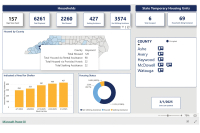Haywood schools improve in state rankings

School performance indicators issued last week paint a picture of a very good Haywood County School System that continues to improve but is still haunted by a few troubling issues.
“I am thrilled with the results and celebrate the success that our district has worked so hard to achieve,” said Chuck Francis, chairman of the Haywood County Board of Education.
Of 115 school districts in the state of North Carolina, just 10 scored better than Haywood County in this year’s district performance composite, which reflects an amalgamation of all state tests and theoretically measures how well schools perform in a given year.
The 11th-place ranking is up from 15th place the last two years and demonstrates even greater growth over the past decade.
“This is the highest we’ve ever performed,” said Superintendent Anne Garrett. “Ten years ago, we were 40th.”
The highest scoring Haywood County school was Riverbend Elementary at 91.9, besting both the state and the county’s average scores of 58.3 and 66.8, respectively.
Related Items
Another performance indicator — academic growth — showed similar successes for Haywood County schools, which are assigned a “met,” “not met” or “exceeded” designation measuring how much learning actually takes place.
Jonathan Valley Elementary was the only Haywood County school found to have exceeded expectations, but 10 of 16 county entities were judged as having met those same expectations.
The final performance indicator issued by the state is a letter grade based upon both performance and growth scores; this year, six Haywood County schools earned Cs and seven earned Bs. Haywood Early College earned an A, and Riverbend Elementary an A+.
Those grades show the continuance of a trend suggesting Haywood County schools are among the elite in the state; for the 2013-14 school year, Haywood County was one of only eight school districts to earn no Ds or Fs — a trend that has persisted on up through this year.
North Carolina’s school accountability program traces its roots to 1996; changes were made in 2012 to focus more on “rigorous career and college readiness standards.”
Detailed results and individual school reports are scheduled for release by the State Board of Education in October, at which time local officials plan to analyze and react.
“We’ll be meeting with schools, and finding out how we can help them grow,” Garrett said.
And some county schools will certainly need that help; Hazelwood Elementary was issued a score of 64.9 and deemed to have “not met” expectations. Hazelwood’s performance is the lowest for an elementary school in the district, not counting the now-shuttered Central Elementary, which scored 60.4.
Among area high schools, Tuscola brought up the rear with a 56.7 score and a “not met” designation. Pisgah High School scored slightly better at 62.1 and is considered to have “met” expectations.
Central Haywood High — an alternative high school with only a few dozen students — came in at 17.2 while earning a “not met” designation. The reasons for the low score were not immediately available.
Conversely, the Haywood Early College — a non-traditional high school that partners with Haywood Community College to offer a five-year diploma that includes an associate’s degree — took top honors, scoring 86.6, meeting expectations, and earning an A.
“Our administration has done an excellent job implementing an improvement plan that has brought us to the top 10 percent in the state,” Francis said. “Our teachers, staff, students and parents deserve credit for smart and diligent work towards those goals.”









